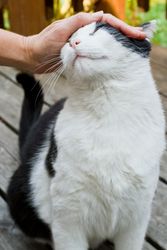How to Handle Petting-Induced Aggression in Cats

Cats are wonderfully independent pets that can provide tons of affection and companionship. But they are also often very, very particular. Your furry friend might be sitting lovingly on your lap one minute and enjoying a good pet only to hiss and flash their claws or teeth the next. This is actually fairly normal behavior for cats, but it sometimes can be adjusted through a bit of training. Here’s all of the important information you need to know about cat aggression from pet sitting experts.
What Is Petting-Induced Aggression?
Every cat has their own limit for social interaction. Some felines will lounge about on your lap for hours and soak up all the affection you can dole out. Others, however, will only last so long before unexpectedly lashing out. This is called “petting-induced aggression,” and while it doesn’t have a single cause, there are some animal instincts at play.
When a cat interacts with another, they might rub or groom each other on the neck or top of the head. Since these areas are associated with friendly interaction, cats typically respond well to being pet in those spots. For some cats with a shorter social fuse, however, pets on the lower back or belly can be confrontational and aggressive stimuli. This can cause the animal to react aggressive in turn, scratching or biting without much warning.
What Are the Signs of Petting-Induced Aggression?
 There are several signs a cat is beginning to feel stressed from petting. You’ll likely notice the cat’s body tense up and then the ears may flatten. Both of these changes in demeanor are signals that something has changed about the interaction. If you keep petting or engaging the cat after these warning signs, it will likely turn aggressive and either run away or go on the offensive with claws and teeth.
There are several signs a cat is beginning to feel stressed from petting. You’ll likely notice the cat’s body tense up and then the ears may flatten. Both of these changes in demeanor are signals that something has changed about the interaction. If you keep petting or engaging the cat after these warning signs, it will likely turn aggressive and either run away or go on the offensive with claws and teeth.
How to Reduce Petting-Induced Aggression
Whether it’s a particular area on their body or a petting time limit, you’ll first want to identify exactly what is making your cat on edge. After you’ve pinpointed the trigger, you’ll be able to interact with your cat right up until it turns aggressive. When you start to see the warning signs, try saying, “down” and calmly lowering him or her to the floor so they can leave and decompress. You may also want to reinforce the interaction with a small treat.
Over time, your cat will begin to understand that you are in control of the friendly interactions and may gradually start to become more comfortable for longer periods of time. You may also want to bring the cat to a veterinarian if the aggression becomes too heightened. The animal could be struggling with an injury or infection that is making them sensitive and on edge.
No matter how your cat interacts with others, the grooming and pet sitting experts of Shar-Jo's Pet Styling & In-Home Pet Sitting in Milford, OH, will treat them with the care and love they deserve. With more than 48 years of experience working with all kinds of animal temperaments, the compassionate staff understands how to handle every pet on their own terms to achieve the best grooming result or to provide care while their owner is away. Visit the website for more information on the services provided or call (513) 831-9457 to speak with a friendly representative today.
About the Business
Have a question? Ask the experts!
Send your question

